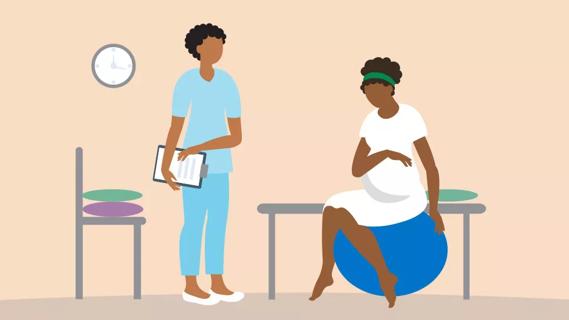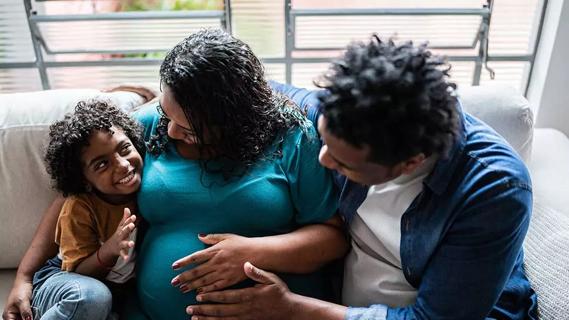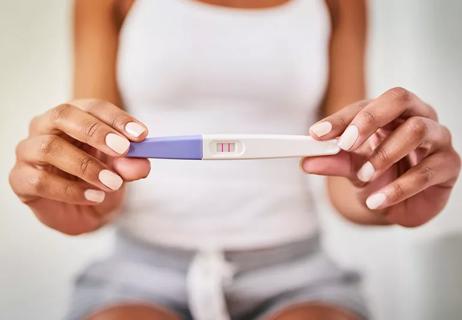Science is mixed, but if you want to try stretching your perineum, here’s how to do it safely

When you get to those last few weeks of pregnancy, your thoughts are likely to turn to questions about labor and delivery. When will labor start? How long will it take? Should I get an epidural? And for many people: How can I make sure I don’t tear down there?
Advertisement
Cleveland Clinic is a non-profit academic medical center. Advertising on our site helps support our mission. We do not endorse non-Cleveland Clinic products or services. Policy
Vaginal tearing is a common worry, and one that your healthcare provider is thinking about, too, says Ob/Gyn Salena Zanotti, MD.
“I hear a lot of questions from people who are pregnant about tearing during delivery, and I get it. No one wants a tear, and your provider doesn’t want it for you either,” Dr. Zanotti says.
In an effort to try to avoid stitches after delivery, some providers and online forums recommend people who are pregnant perform at-home perineal massage in preparation for delivery.
But does it work?
Dr. Zanotti says the research is mixed on whether a perineal massage during pregnancy prevents you from perineal trauma during vaginal delivery, but if it’s something you want to try, it’s not likely to do any harm.
It’s true what they say about childbirth being magical and natural. It’s also true when they say it can be … well, messy. Blood, pooping on the table, tearing in your nether regions — all are more common than you might think.
According to the American College of Obstetricians and Gynecologists (ACOG), between 53% and 79% of people experience lacerations during vaginal childbirth. Those lacerations are usually called vaginal tears or perineal lacerations, in reference to your perineum — the small patch of skin and muscle between your vaginal opening and anus. Your perineum is only about 1.5 inches long, but it’s got a big job to do. It’s essentially the cradle for your pelvic floor — the muscles that help control your ability to do the three Ps: poop, pee and pass gas.
Advertisement
As your body prepares for delivery, the skin of your vagina stretches to allow your baby to pass through. But it doesn’t always stretch enough, and something’s gotta give. Vaginal and perineal tears are common and more likely to happen if:
Tears to your perineum are graded by severity. Some don’t need any intervention. Others will require stitches (which dissolve on their own over time). A first-degree tear is a small injury in the first layer of tissue around the vagina’s perineal area. A fourth-degree tear is the most severe and extends from your vagina through your rectum.
If the idea of tearing during delivery sends a shiver down your spine, that’s normal. No one wants to think about injuries to their most private of parts.
But can you prevent it? You may have heard from your provider or a friend (or a stranger on social media) that you can try massaging or stretching your perineum during your last few weeks of pregnancy to prevent tears.
And, sure, you can. But will it help? Dr. Zanotti says that’s still up for debate.
“Over the years, people have done studies to look at whether perineal massage reduces tears, and you can find studies to back both sides. There’s no consistent answer to the question,” Dr. Zanotti notes.
“When you look at some of the data, you can find studies that show that if you do consistent perineal massage, you might reduce the risks of some advanced tears. And you have other studies that show that it doesn’t make a difference.”
Why the inconsistencies?
To do good science, you need to try to standardize all the variables. In the case of studying something like an at-home perineal massage, that means having to account for things like massage technique, pressure, duration, frequency and more. And that doesn’t even include the litany of factors related to their delivery itself — the baby’s size, how quickly the baby came, interventions taken by healthcare providers and so on and so forth. In other words, it’s a pretty tall order to ensure scientific integrity in such studies.
“It’s difficult to parse out who would have torn anyway and who wouldn’t have and then determine whether perineal massage made a difference,” Dr. Zanotti says. “It’s a complex question.”
So, with scientific indecision in mind, whether you choose to try perineal massage is a personal choice. Just know that even your best efforts may not mean your delivery will necessarily be tear-free, Dr. Zanotti adds.
Advertisement
While you can’t outright prevent your perineum from tearing, massaging it before childbirth and during delivery might reduce the likelihood of it tearing. Or it may potentially lessen the severity of the tear.
“The perineum can be very rigid, and the muscles are tough, particularly if you’ve never delivered a baby vaginally before,” Dr. Zanotti explains. “So, in theory, the idea is that massaging the area can help stretch the muscles and reduce your chances of tearing.”
She recommends talking to your healthcare provider before trying perineal massage to make sure you understand the anatomy of your perineum. You’ll want to make sure you’re pressing in the right places and with the right amount of pressure.
Typically, a perineal massage will follow these steps:
Advertisement
Dr. Zanotti says if you choose to do perineal massage, you should start a few weeks before your anticipated due date, around the 36th week of your pregnancy.
The research studies that show benefits of perineal massage suggest it’s important to massage the area regularly — at least three to four times a week, for at least five minutes at a time.
If perineal massage during your pregnancy isn’t a sure-fire way to prevent vaginal tearing, is there a better solution?
Unfortunately, Dr. Zanotti says there isn’t much that you can do during your pregnancy that has been proven to lower your risk for perineal lacerations. (Or think of it this way: One less thing for you to do in the final weeks before birth!)
“At the end of the day, your best bet for avoiding a tear during vaginal birth is a controlled delivery,” she continues. And to that end, there are some methods providers use during your delivery that aim to reduce your risk of tears.
Research shows that perineal massage during delivery by your provider can help to stretch your perineal tissue to lower your risk of significant tears. Dr. Zanotti says that’s a practice many providers commonly use during childbirth.
“Other methods, like applying a warm compress to the perineum during delivery can help loosen up the tissue as well,” she adds.
Advertisement
Also, the ACOG recommends providers can consider episiotomy (a small cut to widen the opening of the vagina) during delivery when necessary, such as when birth is progressing quickly and the risk for a more severe tear is likely. They’re not as common as they used to be, but in some cases, an episiotomy can reduce the risk of a higher-degree natural tear.
As you think about your birthing experience, it’s natural to worry about tearing. It’s not a possibility anyone wants to consider happening.
But know that perineal tears are something your provider sees often. They know how to help reduce your risk. And if you do have a tear, they’ll know how to treat it.
Learn more about our editorial process.
Advertisement

One is a trained care professional, while the other is a medical caregiver, but both can be important parts of your birthing team

Talk with them about their new sibling early and often

Walking, running, lifting and other exercises can be safe, but avoid contact sports and falling risks

Home pregnancy tests can detect pregnancy just two weeks after ovulation

A fertility expert explains these common concerns

Type 2 diabetes isn’t inevitable with these dietary changes

Applying a hot or cold compress can help with pain